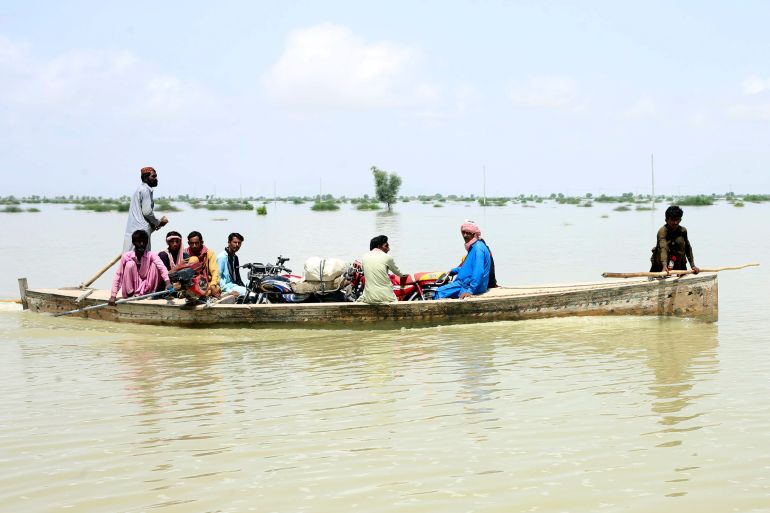Flood-hit Pakistan bids to stop its largest lake from overflowing
UN warns of humanitarian crisis in Pakistan as authorities fear more towns will be flooded if Manchar Lake bursts its banks.

The United Nations has warned that the humanitarian situation in Pakistan was expected to get worse, as authorities tried to prevent the country’s biggest lake from bursting its banks amid unprecedented floods that have inundated a third of the South Asian nation.
Authorities have tried to widen the breach at Manchar Lake in southern Sindh province to lower water levels but that has proved to be futile so far.
Keep reading
list of 3 itemsDeath toll in devastating Pakistan floods crosses 1,300 mark
Pakistan appeals for more aid as flood death toll rises
“We have widened the earlier breach at Manchar to reduce the rising water level,” provincial irrigation minister Jam Khan Shoro told the Reuters news agency.
Already, 100,000 people have been displaced in efforts to keep the lake from overflowing, and if it breaches its banks, it could affect hundreds of thousands more, authorities said.
“After the breach at Manchar, the water has started to flow, earlier it was sort of stagnant,” one resident, Akbar Lashari, said by telephone, following Sunday’s initial breach of the lake.
A local government official Murtaza Shah said on Tuesday that people have helped in strengthening dikes Johi and Mehar towns in Sindh province – one of the worst hit by the monsoon flooding.
Shah added that 80 to 90 percent of the population of the towns had already fled. Those who remain are attempting to strengthen existing dikes with machinery provided by district officials.
The waters have turned the nearby town of Johi into a virtual island, as a dike built by locals holds back the water.
The rising waters have also inundated the nearby Sehwan airport, civil aviation authorities said.
Pakistan has received nearly 190 percent more rain than the 30-year average in July-August, totalling 390.7mm (15.38 inches), with the southern Sindh province getting 466 percent more rain than the average.
More than 33 million people in Pakistan have been affected by the flooding, brought on by record monsoon rainfall amplified by climate change. The floods have caused at least 1,300 deaths and washed away homes, businesses, roads and bridges.
‘The situation could worsen’
With more rain expected in the coming month, the situation could worsen, a top official of the United Nations refugee agency (UNHCR) warned.
“We fear the situation could deteriorate,” said Indrika Ratwatte, the agency’s director for Asia and the Pacific.
“This will increase challenges for flood survivors, and likely worsen conditions for nearly half a million displaced people, forcing more to abandon their homes.”
The UNHCR has launched an air bridge to deliver aid from Dubai.
The first four flights took off on Monday, said Ratwatte. Six other flights are planned, with mattresses, tarpaulins and cooking utensils on board.
“The food insecurity is going to be huge because the crops are devastated, obviously, and the little they had in terms of livestock is also destroyed,” she said.

About 636,940 displaced people have been housed in tent villages, the UN said, adding the raging waters had swept away 1.6 million houses, roads, rail and telecommunication systems, and inundated more than two million acres (more than 800,000 hectares) of farmland, destroying both standing and stored crops.
Officials have estimated that the economic cost of the losses is a minimum of $10bn.
Rice fields in the southern Sindh province resembled massive lakes of several miles in diameter, according to aerial video footage by the Pakistani military.
The region already faced the dangers of waterborne and skin diseases, dengue fever, snake bites and breathing issues, Azra Fazal Pechuho, health minister for the southern Sindh province, told a news briefing.
Mortality among newborn babies and severe acute malnutrition are at risk of increasing due to disruption of services.
The UN’s World Health Organization said more than 1,460 health centres had been damaged, of which 432 were fully wrecked, the majority of them in Sindh.
More than 4,500 medical camps have been set up by the WHO and its partners, while more than 230,000 rapid tests for acute watery diarrhoea, malaria, dengue, hepatitis and chikungunya have been distributed.
Such diseases are already circulating in Pakistan, alongside COVID-19, HIV and polio, and “now all these are at risk of getting worse”, WHO spokesman Tarik Jasarevic told reporters in Geneva.
“We have already received reports of an increased number of cases of acute watery diarrhoea, typhoid, measles and malaria, especially in the worst-affected areas.”
It is appealing for $19m from donors. Pakistan is also appealing for aid.